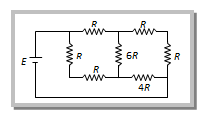12th Grade > Physics
WORK POWER AND ENERGY MCQs
Work And Energy, Sources Of Energy, Electric Potential Energy Potential And Dipoles
Total Questions : 109
| Page 5 of 11 pages
Answer: Option C. -> k2q3
:
C
V=V1+V2+V3+.......=14πϵ0[q1r1−q2r2+q3r3−q4r4+.......]=k[q1−q2+q4−q8+......]=kq[1−12+122−123+......]=kq[11+12]=2kq3
:
C
V=V1+V2+V3+.......=14πϵ0[q1r1−q2r2+q3r3−q4r4+.......]=k[q1−q2+q4−q8+......]=kq[1−12+122−123+......]=kq[11+12]=2kq3
Answer: Option B. -> Vx=−xE0
:
B
∵E=−dVdX⇒Vx=−xE0
:
B
∵E=−dVdX⇒Vx=−xE0
Answer: Option D. -> −pE cosθ
:
D
Potential energy of dipole in electric field is U=−pEcosθ; where θ is the angle between electric fieldand dipole moment vector.
:
D
Potential energy of dipole in electric field is U=−pEcosθ; where θ is the angle between electric fieldand dipole moment vector.
Answer: Option B. -> The field is non-zero but potential is zero
:
B
Obviously, from charge configuration, at the centre electric field is non-zero. Potential at the centre due to 2q charge is V2q=2qr

and the potential due to – q charge is
V−q=−qr (r = distance of centre)
∴ Total potential V=V2q+V−q+V−q=0
:
B
Obviously, from charge configuration, at the centre electric field is non-zero. Potential at the centre due to 2q charge is V2q=2qr

and the potential due to – q charge is
V−q=−qr (r = distance of centre)
∴ Total potential V=V2q+V−q+V−q=0
Answer: Option C. -> Both of the above
:
C
x=dq2q1±1;x1=dq2q1+1=66020+1=4cmx2=166020−1=162=8cm
point outside
:
C
x=dq2q1±1;x1=dq2q1+1=66020+1=4cmx2=166020−1=162=8cm
point outside
Answer: Option A. -> + 2kV
:
A
Work done W=Q(VB−VA)⇒(VB−VA)=WQ=10×10−35×10−6J/C=2kV
:
A
Work done W=Q(VB−VA)⇒(VB−VA)=WQ=10×10−35×10−6J/C=2kV
Answer: Option C. -> √g2√3
:
C
If A moves down the incline by 1 m, B shal move up by 12m.
If the speed of B is v, then the speed of A will be 2v.
From conservation of energy,
Gain in KE = loss in PE
12mA(2v)2+12mBv2=mAg×35−mBg×12
Solving, we get
v=√g2√3
:
C
If A moves down the incline by 1 m, B shal move up by 12m.
If the speed of B is v, then the speed of A will be 2v.
From conservation of energy,
Gain in KE = loss in PE
12mA(2v)2+12mBv2=mAg×35−mBg×12
Solving, we get
v=√g2√3
Answer: Option C. -> No work at all
:
C
No displacement is there.Hence work is zero.
:
C
No displacement is there.Hence work is zero.
Answer: Option C. -> Directly proportional to t4
:
C
f = kt
m∫v0 dv = k∫t0 tdt
mv = kt2
v = kmt2
KE = 12mv2=12mk2m2t4 = (k22m )t4
KE α t4
:
C
f = kt
m∫v0 dv = k∫t0 tdt
mv = kt2
v = kmt2
KE = 12mv2=12mk2m2t4 = (k22m )t4
KE α t4
Answer: Option C. -> 900
:
C
A2+B2+2ABcosθ=A2+B2−2Acosθ⇒4ABcosθ=0⇒cosθ=0⇒θ=90∘
:
C
A2+B2+2ABcosθ=A2+B2−2Acosθ⇒4ABcosθ=0⇒cosθ=0⇒θ=90∘
















